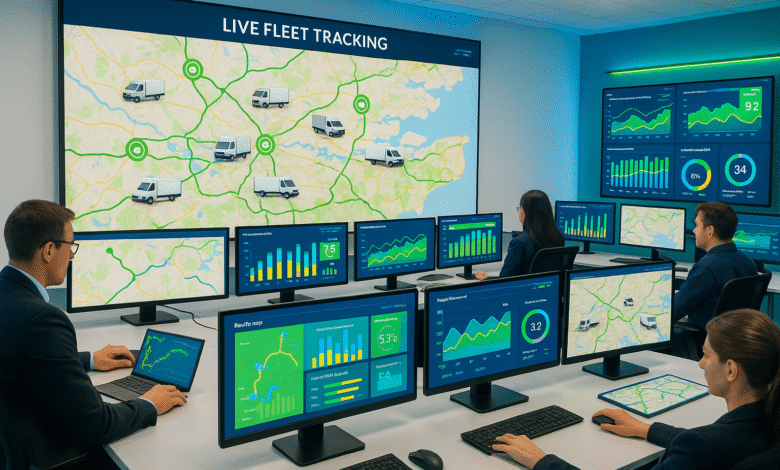Fleet Management Optimization: GPS and Telematics Integration Strategies
This article looks at how GPS and telematics solutions are being used to transform fleet management—and why they’re becoming essential for success.

In today’s fast-moving business world, managing a vehicle fleet efficiently can give companies a real edge. GPS tracking and telematics systems are changing the game, helping businesses track, manage, and improve their fleet operations like never before.
These tools do more than just reduce fuel and maintenance costs—they boost safety, help meet regulations, and improve overall performance. With rising fuel prices, strict environmental rules, and fewer available drivers, modern fleets face big challenges. But companies that adopt smart tracking technology are better equipped to handle these issues and stay ahead of the competition.
This article looks at how GPS and telematics solutions are being used to transform fleet management—and why they’re becoming essential for success.
Understanding Fleet Management Optimization
Fleet management optimization encompasses the systematic improvement of all aspects related to commercial vehicle operations. This multifaceted approach involves leveraging advanced technologies, data analytics, and strategic planning to maximize efficiency while minimizing costs and risks. The optimization process extends beyond simple vehicle tracking to encompass comprehensive operational intelligence that drives informed decision-making.
The foundation of effective fleet optimization lies in the seamless integration of multiple technological components. GPS tracking systems provide real-time location data, while telematics platforms collect and analyze vast amounts of operational information. When these technologies work in harmony, they create a powerful ecosystem that transforms raw data into actionable insights for fleet managers.
Modern fleet optimization strategies recognize that every vehicle, driver, and route represents potential areas for improvement. By implementing comprehensive monitoring and analysis systems, organizations can identify inefficiencies, predict maintenance needs, and optimize resource allocation. This proactive approach to fleet management significantly reduces reactive costs while improving service delivery and customer satisfaction.
The Evolution of GPS Technology in Fleet Management
GPS technology has revolutionized fleet management by providing unprecedented visibility into vehicle locations and movements. The evolution from basic tracking systems to sophisticated positioning platforms has enabled fleet managers to implement more precise and effective optimization strategies. Modern GPS systems offer accuracy within meters, enabling precise route planning and real-time traffic optimization.
The integration of GPS technology with cloud-based platforms has democratized access to advanced fleet management capabilities. Small and medium-sized enterprises can now access enterprise-level tracking and optimization tools without significant infrastructure investments. This accessibility has accelerated the adoption of GPS-based fleet management solutions across various industries.
Advanced GPS systems now incorporate features such as geofencing, landmark recognition, and predictive routing. These capabilities enable fleet managers to create virtual boundaries, receive alerts for unauthorized vehicle usage, and optimize routes based on historical traffic patterns. The combination of real-time positioning data with predictive analytics has transformed GPS from a simple tracking tool into a comprehensive optimization platform.
Telematics: The Backbone of Modern Fleet Operations
Telematics technology serves as the central nervous system of modern fleet management, collecting and transmitting critical operational data from vehicles to centralized management platforms. This technology extends far beyond basic location tracking to include engine diagnostics, fuel consumption monitoring, driver behavior analysis, and maintenance scheduling. The comprehensive data collection capabilities of telematics systems enable fleet managers to make data-driven decisions that significantly impact operational efficiency.
The integration of telematics with fleet management systems creates a comprehensive view of vehicle performance, driver behavior, and operational costs. This holistic approach enables organizations to identify trends, predict potential issues, and implement preventive measures. The real-time nature of telematics data allows for immediate response to emergencies, route deviations, and maintenance alerts.
Modern telematics platforms utilize advanced sensors and onboard diagnostics to monitor various vehicle parameters continuously. This continuous monitoring capability enables predictive maintenance scheduling, fuel efficiency optimization, and driver safety improvements. The integration of artificial intelligence and machine learning algorithms further enhances the analytical capabilities of telematics systems, providing increasingly sophisticated insights into fleet operations.
Strategic Integration Approaches
The successful integration of GPS and telematics technologies requires a strategic approach that aligns with organizational objectives and operational requirements. Fleet management optimization through technology integration involves careful planning, phased implementation, and continuous refinement of systems and processes. Organizations must consider their specific needs, budget constraints, and technological capabilities when developing integration strategies.
A comprehensive integration strategy begins with a thorough assessment of current fleet operations and identification of optimization opportunities. This assessment should evaluate existing technologies, operational processes, and performance metrics to establish baseline measurements. The integration plan should prioritize high-impact areas while considering the organization’s capacity for change management and technology adoption.
The phased implementation approach allows organizations to manage risks while maximizing benefits. Initial phases typically focus on core tracking and monitoring capabilities, while subsequent phases introduce advanced analytics, predictive maintenance, and driver behavior optimization. This gradual approach enables organizations to learn from early implementations and refine their strategies based on real-world experience.
Key Benefits of GPS and Telematics Integration
The integration of GPS and telematics technologies delivers numerous benefits that directly impact operational efficiency and profitability. Fleet management optimization through these technologies typically results in significant cost reductions, improved safety records, and enhanced customer satisfaction. The comprehensive visibility provided by integrated systems enables fleet managers to make informed decisions that optimize resource utilization and minimize waste.
Fuel cost reduction represents one of the most immediate and measurable benefits of GPS and telematics integration. By monitoring fuel consumption patterns, identifying inefficient routes, and optimizing driving behaviors, organizations can achieve substantial savings in fuel expenses. The real-time monitoring capabilities enable immediate response to fuel theft, unauthorized usage, and inefficient driving practices.
Safety improvements through integrated fleet management systems protect both drivers and company assets while reducing insurance costs and liability exposure. Advanced driver assistance systems, combined with telematics monitoring, enable proactive safety management through behavior analysis, training recommendations, and incident prevention. The comprehensive data collection capabilities provide valuable insights for safety program development and risk management.
Implementation Challenges and Solutions
The implementation of integrated GPS and telematics systems presents several challenges that organizations must address to ensure successful deployment. Fleet management optimization initiatives often encounter resistance from drivers, technical integration difficulties, and data management complexities. Understanding these challenges and developing appropriate solutions is crucial for successful implementation.
Driver acceptance represents a significant challenge in fleet management technology deployment. Concerns about privacy, job security, and increased monitoring can create resistance to new systems. Organizations must develop comprehensive change management programs that address these concerns while highlighting the benefits of technology integration. Training programs, transparent communication, and involvement in system selection can help build driver acceptance and support.
Technical integration challenges often arise when connecting new systems with existing fleet management infrastructure. Legacy systems, data compatibility issues, and network connectivity requirements can complicate implementation efforts. Organizations should work closely with technology vendors to develop integration plans that address these technical challenges while minimizing operational disruptions.
Advanced Analytics and Reporting
The integration of GPS and telematics technologies generates vast amounts of data that require sophisticated analytics capabilities to extract meaningful insights. Fleet management optimization relies heavily on the ability to analyze complex datasets and identify patterns that inform strategic decisions. Advanced analytics platforms utilize machine learning algorithms and artificial intelligence to process large volumes of operational data and generate actionable recommendations.
Predictive analytics capabilities enable fleet managers to anticipate maintenance needs, optimize routes based on historical patterns, and identify potential safety issues before they become problems. These predictive capabilities transform fleet management from reactive to proactive, enabling organizations to prevent issues rather than simply responding to them. The integration of weather data, traffic patterns, and historical performance metrics creates comprehensive predictive models that improve operational efficiency.
Real-time reporting capabilities provide fleet managers with immediate access to critical operational information. Customizable dashboards and automated alerts ensure that managers can quickly identify and respond to emerging issues. The ability to generate detailed reports on various aspects of fleet operations supports compliance requirements and provides valuable insights for continuous improvement initiatives.
Cost-Benefit Analysis and ROI Measurement
The implementation of integrated GPS and telematics systems requires significant financial investment, making cost-benefit analysis and return on investment (ROI) measurement critical components of fleet management optimization strategies. Organizations must carefully evaluate the total cost of ownership, including hardware, software, installation, training, and ongoing support expenses, against the expected benefits and savings.
Direct cost savings typically include reduced fuel consumption, lower maintenance costs, decreased insurance premiums, and improved route efficiency. These tangible benefits can be measured and tracked to demonstrate the financial impact of technology integration. The payback period for integrated fleet management systems typically ranges from 12 to 24 months, depending on fleet size and operational complexity.
Indirect benefits, while more difficult to quantify, often provide substantial value to organizations. Improved customer satisfaction, enhanced safety records, better regulatory compliance, and increased operational flexibility contribute to long-term competitive advantages. These benefits should be considered when evaluating the overall value proposition of integrated fleet management systems.
Future Trends and Emerging Technologies
The future of fleet management optimization will be shaped by emerging technologies that further enhance the capabilities of GPS and telematics integration. Artificial intelligence and machine learning will continue to improve predictive capabilities, while Internet of Things (IoT) devices will provide even more comprehensive monitoring and control capabilities. The integration of these technologies will create increasingly sophisticated fleet management platforms.
Autonomous vehicle technology represents a significant future trend that will fundamentally change fleet management requirements. The integration of autonomous systems with existing GPS and telematics platforms will create new opportunities for optimization while presenting unique challenges for fleet managers. Organizations must prepare for this transition by developing flexible technology architectures that can accommodate evolving requirements.
Electric and hybrid vehicle adoption will require modifications to existing fleet management systems to accommodate new monitoring and optimization requirements. Battery management, charging infrastructure integration, and route optimization for electric vehicles will become increasingly important considerations for fleet managers. The integration of these capabilities with existing GPS and telematics systems will be crucial for successful electric fleet management.
Industry-Specific Applications
Different industries have unique requirements and challenges that influence fleet management optimization strategies. The transportation and logistics industry focuses heavily on route optimization, delivery scheduling, and fuel efficiency. Construction companies prioritize equipment tracking, maintenance scheduling, and safety compliance. Emergency services require real-time location tracking and rapid response capabilities.
The healthcare industry utilizes fleet management systems for ambulance dispatch, medical equipment tracking, and patient transport optimization. Food service and delivery companies focus on temperature monitoring, delivery time optimization, and customer satisfaction metrics. Each industry requires customized approaches to GPS and telematics integration that address specific operational requirements.
Service-based businesses, such as utilities and telecommunications, rely on fleet management systems for technician scheduling, equipment tracking, and customer service optimization. The integration of GPS and telematics technologies enables these organizations to improve response times, reduce operational costs, and enhance customer satisfaction through better service delivery.
Regulatory Compliance and Safety Standards
Fleet management optimization must address increasingly stringent regulatory requirements and safety standards that govern commercial vehicle operations. Electronic logging devices (ELDs), hours-of-service regulations, and environmental compliance requirements create complex compliance challenges that integrated GPS and telematics systems can help address.
The integration of compliance monitoring capabilities with fleet management systems enables automated tracking and reporting of regulatory requirements. This automation reduces administrative burden while ensuring accurate compliance documentation. The real-time monitoring capabilities provide immediate alerts for potential violations, enabling proactive management of compliance issues.
Safety regulations continue to evolve, requiring fleet managers to implement comprehensive safety management programs. Integrated systems provide valuable data for safety program development, incident investigation, and driver training initiatives. The ability to monitor driver behavior, vehicle performance, and operational conditions supports proactive safety management approaches.
Conclusion
The integration of GPS and telematics technologies represents a transformative opportunity for organizations seeking to optimize their fleet operations. Fleet management optimization through these integrated systems delivers significant benefits, including reduced operational costs, improved safety records, and enhanced customer satisfaction. The comprehensive visibility and control provided by these technologies enable fleet managers to make informed decisions that drive operational excellence.
Successful implementation requires careful planning, strategic thinking, and commitment to change management. Organizations must consider their specific needs, operational requirements, and technology capabilities when developing integration strategies. The phased approach to implementation allows organizations to manage risks while maximizing benefits through continuous improvement and refinement.
The future of fleet management will continue to evolve with emerging technologies and changing industry requirements. Organizations that invest in flexible, scalable technology platforms will be better positioned to adapt to these changes while maintaining competitive advantages. The integration of GPS and telematics technologies provides the foundation for this technological evolution, enabling organizations to optimize their operations while preparing for future challenges and opportunities.
The investment in integrated fleet management systems represents a strategic decision that impacts long-term operational efficiency and competitive positioning. Organizations that embrace these technologies and implement comprehensive optimization strategies will be well-positioned to succeed in an increasingly complex and competitive business environment. The combination of GPS tracking, telematics monitoring, and advanced analytics creates a powerful platform for fleet management optimization that delivers measurable results and sustainable competitive advantages.











